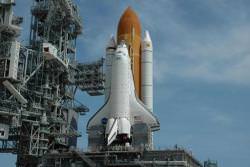Space shuttle Atlantis’ STS-122 mission to the International Space Station has been further delayed and now is targeted to launch no earlier than Jan. 2. The liftoff date hinges on the resolution of a repeat failure of the shuttle’s fuel sensor system. NASA has not yet made a final decision if repairs to the system will be done on the launch pad or if Atlantis will need to be rolled back to the Vehicle Assembly Building where the external tank can be removed.
“It would depend on what we find…but we have a lot of options in front of us,� said NASA’s Mission Management Team chairman LeRoy Cain at Sunday morning press briefing. Cain added that if they do decide to roll back, that probably would not support a January 2 launch. However, STS-122 Launch Director Doug Lyons said he couldn’t envision a scenario that would necessitate a rollback. “We have almost limitless access (to the tank) and there are not many things we can’t do on the launch pad that we could do at the VAB.�
Early Sunday, one of the four engine cutoff (ECO) sensors inside the liquid hydrogen section of Atlantis’ external fuel tank gave a false reading while the tank was being filled. NASA’s new and updated Launch Commit Criteria require that all four sensors function properly. Following Friday’s launch scrub, the MMT decided to shorten the launch window to one minute in an effort to work around the sensor problem. Upon launch, this would send the shuttle on a direct trajectory to the space station, and would save fuel. Fuel depletion is what drives the need for the ECO sensors which protect the shuttle’s main engines by triggering engine shut down if fuel runs unexpectedly low. But the MMT also added the criteria that a failure of any of the four sensors would prompt a launch scrub.
Previously, the criteria required that three of the four sensors had to function properly. Atlantis’ scheduled launch on Thursday, Dec. 6, was delayed after two liquid hydrogen ECO sensors gave false readings. A third sensor gave a false reading while the tank was being emptied.
Meanwhile, ISS flight controllers informed space station commander Peggy Whitson that she and crewmate Dan Tani likely will be asked to carry out a spacewalk later this month to inspect a problematic solar array rotary joint on the right side of the lab’s main power truss. If the launch of STS-122 had gone as planned, a team of shuttle astronauts would have conducted the inspection.
The crew of STS-122 will come out of quarantine and return to Houston.
The main objective of Atlantis’ mission is to deliver, install and activate the European Space Agency’s Columbus laboratory, which will provide scientists around the world the ability to conduct a variety of life, physical and materials science experiments.
Following STS-122, the next two flights on the shuttle manifest for space station construction are scheduled for launch in mid February and late April. The next flight after that is an August mission to service the Hubble Space Telescope. Bill Gerstenmaier, Associate Administrator of spaceflight operations at NASA said that this delay shouldn’t affect NASA’s ability to complete station construction before the shuttle is scheduled to be retired in 2010. “This doesn’t impact the overall manifest. With the remaining time we can accomplish all the flights,� Gerstenmaier said.
Original News Source: NASA TV

